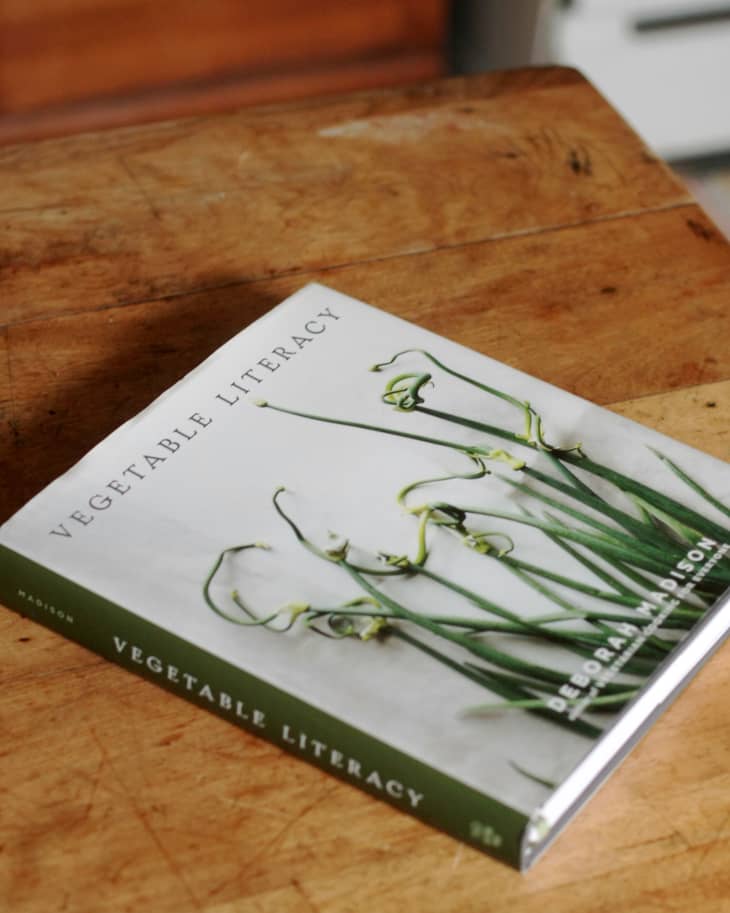Vegetable Literacy by Deborah Madison
A new cookbook by Deborah Madison is always much anticipated in my household, so when Vegetable Literacy was first released, I was really looking forward to spending some time with it in the kitchen before writing this review. I was not surprised to find that the recipes were well-written and fool-proof, for this is the hallmark of any cookbook by Deborah Madison. Nor was I surprised that it was beautifully produced with a good binding, heavy paper, and lovely photographs, as it was published by Ten Speed Press and they know how to do cookbooks.
So I cannot report any surprises, but I can express my delight for this lovely, well-reseached, vegetable-forward celebration of the relationships between the plants we find in our garden (or market) and how they play out with delicious results in our kitchen.
Quick Facts
• Who wrote it: Deborah Madison
• Who published it: Ten Speed Press
• Number of recipes: 300
• Recipes for right now: Chilled, Spicy Carrot Soup with Yogurt Sauce; Peas with Baked Ricotta and Bread Crumbs; Corn Simmered in Coconut Milk with Thai Basil; Sautéed Zucchini with Mint, Basil, and Pine Nuts; Braised Leeks with Lovage and Lemon; Steamed, The Roasted or Panfried Beets; Open-faced Sandwich of Spinach, Caramelized Onions, and Roasted Peppers; Braised Summer Cabbage.
• Other highlights:
Deborah Madison’s earlier cookbooks (The Green’s Cookbook, The Savory Way) are the reason why I am the kind of cook I am today. Back then in the 80s and 90s, people wanting to cook vegetable-forward food with local produce were a somewhat fringe group, unlike today where this style of cooking is being universally embraced as the most delicious and healthy way to go. Deborah Madison was at the forefront of this movement toward a more sustainable way to cook and eat, and with her latest book, she digs deep into the most local of all: our backyard vegetable gardens.
For much of her adult life, Deborah wasn’t in the position to tend her own vegetable garden, mostly due to the amount of travel required for her career as a food writer. But a few years ago, she decided to slow things down a little and plant a garden in her yard in New Mexico. Here she was able to explore her love of plants and gardening and her interest in botany, and to play with an idea she has been carrying around with her for a while: Do plants that share the same botanical family naturally have an affinity at the table?
Skip forward a few years and I think we have the answer in this big, beautiful, 500 page cookbook with 300 recipes and numerous full-color photographs. The book is divided into 12 vegetable families: carrot, mint, sunflower, knotweed, cabbage, nightshade, goosefoot/amaranth, lily (former), cucurbit, grass, legume and morning glory. Each chapter looks at the herbs and vegetables we usually eat from each family, and offers general information, details on varieties, uses for the whole plant, kitchen wisdom, culinary companions, and finally, several recipes.
Taking the Legume Family section as an example, we first explore fresh peas with recipes such as Pea, Leek, and Sorrel Soup that can be served hot or chilled. Continuing on, there are subsections and recipes for dried peas and shelling peas, and from there, it’s peanuts, favas, lentils, soybeans, dried beans, green beans, and chickpeas. As with all the chapters in this book, this is a thorough, interesting, entertaining and quite practical introduction to this family of vegetables.
As previously mentioned, the recipes here are very well written and reliable. A novice cook can pick up this book with as much ease as an experienced cook and both will find plenty here to keep them busy in the kitchen. The photographs are beautiful and inspirational, something to which the beautiful cover photo only hints.
The return to a more local, garden-based way of eating has its critics and controversies. Personally I welcome this debate as I feel this is an important and quite literally life-changing topic. When I read and work from a book such as this, it only confirms my commitment to knowing and understanding the plant world from which I receive one of the deepest most essential pleasures I know: to eat well. It deepens, too, my commitment to finding ways to make this way of living available to everyone. Thank you, Deborah, for once again being such a lovely and delicious inspiration!
• Who would enjoy this book? If you have a garden and are interested in the botanics of vegetables, then of course this is for you. But even if you live on the top floor of a big city high rise, you can still find much that is relevant here, especially if you love simple but deeply flavored, vegetable-forward food. With a decent market nearby and this book in your hands, the rest will naturally and deliciously follow!
Find the book at your local library, independent bookstore, or Amazon: Vegetable Literacy by Deborah Madison
• Visit the author’s website: Deborah Madison
Apartment Therapy Media makes every effort to test and review products fairly and transparently. The views expressed in this review are the personal views of the reviewer and this particular product review was not sponsored or paid for in any way by the manufacturer or an agent working on their behalf. However, the manufacturer did give us the product for testing and review purposes.
(Images: Dana Velden)
